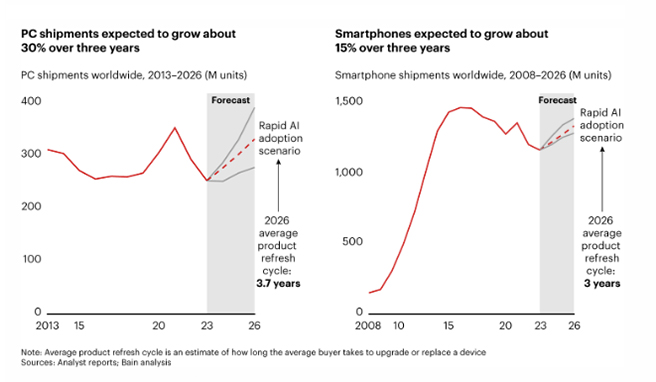Global tech supply chains are facing the risk of another round of chip shortages, brought on primarily by an ‘insatiable’ demand for artificial intelligence and, also, changing climates.
The continuing frenzy to bring AI-capabilities to everything from smartphones to electric vehicles has meant that pressure is piling on semiconductor supply chains — one that may be difficult to fill.
“The semiconductor supply chain is incredibly complex, and a demand increase of about 20% or more has a high likelihood of upsetting the equilibrium and causing a chip shortage,” US consultant Bain & Company said in an analysis published on Wednesday.
Also on AF: Taiwan’s Export Boom Continues, Fuelled by Global AI Demand
The current “AI explosion … could easily surpass that threshold,” it added.
In the report released on Wednesday, Bain forecasted a 30% jump in demand for key chip components by 2026, spurred by a rush to buy graphics processing units (GPUs) for data centres.
Data centres can require between hundreds and thousands of GPUs to train the large language models needed to develop and update AI models.

Aside from GPUs, a sharp uptick in demand is also likely to be brought on by the increasing use of AI in personal devices.
According to Bain estimates, rapid AI adoption could translate into a 31% jump in global personal computer (PC) sales and a 15% uptick in smartphone sales.
That would mean fabs making the most cutting edge chips — 5 nanometer (nm) and below — will need to hike up their output by 25% to 35%.
It would also mean that leading semiconductor makers would need to establish four or five advanced wafer fabs. The cost of those fabs would be between $40 billion and $75 billion, Bain estimated.

Climate change threat
With the tech industry looking to enable everything from home robots to smart light bulbs with AI, the jump in demand looks to be inevitable.
But that is only one piece of the puzzle.
Exacerbating the risk to the chip supply chain are a range of other factors including climate change, natural disasters and geopolitical tensions, Bain noted.
In the last 18 months, “much of the pressure on GPU supply was caused by disruptions to less visible elements of the supply chain, such as CoWoS advanced packaging capabilities,” it added.
Unpredictable weather changes brought on by rising global temperatures pose a major threat to chip supply chains — primarily because a resulting shortage of water could derail wafer fab operations.
A major case in point is Taiwan — home to the world’s largest and most important chipmaker TSMC — where a persistent drought has been giving authorities headaches since 2021.
TSMC makes 90% of the world’s advanced chips that power every category of electronic devices around the world. It is the top supplier of advanced chips to companies like Nvidia, Apple, AMD, Qualcomm and ARM.
It also consumes nearly 10 million gallons of water per day.
That’s because chip fabs need water in all stages of manufacturing — from cooling systems to generating electricity. A huge amount of ‘ultrapure’ water is also needed in the fabrication process itself, to wash off residue from silicon chips.
Those needs have meant that chipmakers across the globe are already consuming as much water as Hong Kong, a city of 7.5 million people.
All it takes is one missing chip
For TSMC, the collision of such massive water demands with the ongoing drought has meant hauling in “truckloads of water” from other areas.
The Taiwanese government is also taking a range of measures to keep water flowing to TSMC, including seeding clouds in the chipmaker’s home town and paying farmers in the area to not irrigate their farmlands.
According to S&P Global, mismanagement of its water supply could cost TSMC 10% of its production by 2030.
Geopolitical risks are also particularly concerning in the case of TSMC, whose most important fabs operate at just three sites in Taiwan, making the global chip supply chain “quite fragile.”
In April, for instance, Taiwan was hit by its biggest earthquake in 25 years, resulting in operations being halted at TSMC. The chipmaker said the quake would result in a $60 million hit to its second-quarter earnings.
Taiwan also faces the risk of an invasion from China, which claims the self-governed island as its own territory. Last year, the top US intelligence official said any such move by China could halt operations at TSMC and cost the world $1 trillion per year.
Additionally, the Bain report cautioned that increasing geopolitical tensions between China and the West and tightening trade restrictions also pose “serious risks” to semiconductor supply.
“One missing chip could derail the entire system,” it said.
- Vishakha Saxena
Also read:
Global Chip Sector ‘Can Never Return to its Pre-Covid Set-up’
China Threatens to Cut Off ASML Over New US Chip Curbs
Japan Nears China Chip Curbs Deal With ‘Bad Cop, Very Bad Cop’ US
US Pressing Korean Chipmakers For More China Chip Curbs
US Push to Curb China Chip Tech Economically Motivated: ASML CEO
China’s Critical Minerals Blockade Risks Global Chip Shortage
US May Sanction China’s DRAM Chip Giants Next, Analyst Warns
US Tech Firms Face ‘Death Spiral’ From New China Curbs: Lawmakers
Threat of More Chip Curbs Spurs Warnings on China Innovation
China to Lead 2024 Chip Expansion with 18 New Fabs – SEMI























